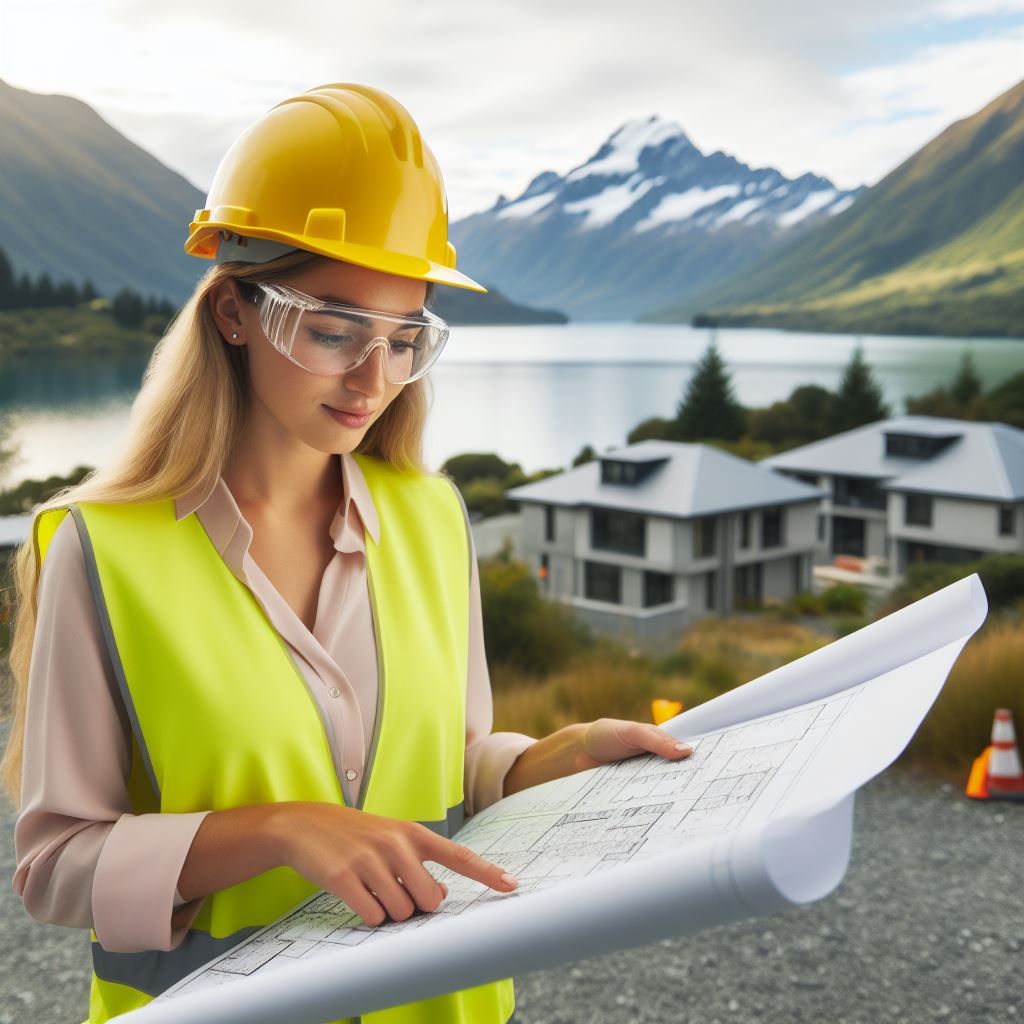Introduction
In recent years, sustainable development has become a global priority, prompting countries like New Zealand to embrace green building practices.
A. Explanation of green building
Green building refers to the design, construction, and operation of buildings that prioritize environmental sustainability.
B. Importance of green building in the context of New Zealand
New Zealand faces numerous environmental challenges, such as climate change and resource depletion.
Embracing green building practices is crucial for reducing the country’s carbon footprint and preserving its natural resources.
C. The role of civil engineering in the green building industry in NZ
Civil engineering plays a crucial role in the green building industry in New Zealand.
Civil engineers design and construct eco-friendly structures, ensuring they are energy-efficient and utilize sustainable materials.
They also incorporate innovative technologies to reduce waste and enhance environmental performance.
Additionally, civil engineers work with architects and contractors to develop sustainable water and waste management systems, further minimizing the environmental impact of buildings.
Furthermore, they ensure that green buildings adhere to strict environmental regulations and certifications, such as Green Star and Homestar.
Through their expertise, civil engineers contribute significantly to the growth and success of the green building industry in New Zealand.
History of Green Building in NZ
- New Zealand has a long-standing tradition of embracing sustainable building practices.
- Green building principles have been woven into the culture and values of the country.
- In the 1970s, the concept of energy-efficient housing gained traction in NZ.
- Early efforts focused on passive design techniques and energy conservation strategies.
- The first green building projects emerged in the 1980s, demonstrating innovative sustainable features.
A. Evolution of Green Building Practices in NZ
- Since the 1990s, NZ has witnessed a significant shift towards more holistic green building practices.
- Green Star, a rating system for sustainable buildings, was introduced in NZ in 2007.
- The Green Building Council of New Zealand plays a crucial role in promoting green building practices.
- Designers and architects have embraced innovative approaches such as eco-friendly materials and renewable energy.
- Emphasis is now placed on life-cycle assessment, carbon footprint reduction, and water conservation.
B. Development and Implementation of Sustainable Building Codes and Standards
- NZ has taken significant strides in developing and implementing sustainable building codes and standards.
- The Building Code sets minimum requirements for energy efficiency, insulation, and environmental impact.
- The Homestar rating system evaluates the overall environmental performance of residential buildings.
- Building consent processes now prioritize sustainable design and construction practices.
- Government agencies and industry stakeholders collaborate to improve sustainable building regulations.
C. Key Milestones and Achievements
- In 2006, the Zero Energy House in Pt Chevalier became NZ’s first 6-star Homestar-rated home.
- The Wynyard Quarter Sustainability Framework was introduced in Auckland in 2012.
- In 2017, Green Star-rated buildings accounted for 34% of NZ’s office space.
- Christchurch’s cardboard cathedral, constructed after the earthquake, showcased innovative sustainable design.
- The New Zealand Green Building Council celebrated its 500th Green Star-certified project in 2020.
Basically, New Zealand has a rich history of embracing green building practices, evolving towards more holistic approaches, and developing sustainable codes and standards.
Milestones and achievements highlight the country’s dedication to environmental consciousness in the civil engineering sector.
Read: The Future of Electrical Engineering in NZ
Civil Engineering Practices in Green Building
- Sustainable design principles are incorporated into civil engineering projects to promote environmental consciousness.
- Civil engineers take into account the environmental impact and energy efficiency of their projects.
- The use of renewable materials and technologies in construction is a key aspect of green building.
- Efficient water and waste management systems are crucial for the success of green building projects.
A. Incorporation of sustainable design principles in civil engineering projects
Green building is a concept that focuses on creating environmentally friendly structures and promoting sustainability.
Civil engineering plays a pivotal role in this movement, as it involves the planning, design, construction, and maintenance of infrastructure and buildings.
By incorporating sustainable design principles into their projects, civil engineers can contribute significantly to the promotion of environmental consciousness and protection.
B. Consideration of environmental impact and energy efficiency
When carrying out civil engineering projects, professionals prioritize the consideration of environmental impact and energy efficiency.
They conduct thorough research and analysis to determine the various ways in which their projects can minimize resource consumption and reduce carbon footprint.
Civil engineers ensure environmental friendliness by designing efficiently, using renewables, and employing innovative construction techniques.
C. Renewable materials and technologies in construction
The use of renewable materials and technologies in construction is another crucial aspect of green building.
Civil engineers prioritize the selection of materials that have a low impact on the environment, such as recycled or locally sourced materials.
They actively use sustainable technologies like solar panels, minimizing reliance on non-renewables and reducing environmental impact.
D. Importance of efficient water and waste management systems
Efficient water and waste management systems also play a vital role in green building.
Civil engineers design and implement sustainable solutions that promote water conservation, such as the use of water-efficient fixtures and the incorporation of greywater recycling systems.
They also prioritize waste management by implementing recycling programs, utilizing sustainable construction practices, and promoting the use of materials that can be recycled or repurposed.
Civil engineers actively integrate sustainable design, assess environmental impact, prioritize energy efficiency, utilize renewables, and optimize water and waste management.
By adopting these practices, civil engineers contribute to the creation of environmentally conscious structures that promote sustainability and protect the planet for future generations.
Read: NZ Electrical Engineering: Industry Insights
Examples of Green Building Projects in NZ
Green building projects in New Zealand have seen significant advancements in recent years, emphasizing sustainability and eco-friendly practices.
A. Significant Green Building Projects Across the Country
New Zealand has witnessed the rise of numerous remarkable green building projects across the country.
These projects showcase the country’s commitment to sustainable development and environmental consciousness.
1. Christchurch Civic Building
The Christchurch Civic Building is a prime example of a green building project aimed at reducing carbon emissions.
It features energy-efficient systems, eco-friendly materials, and innovative insulation techniques, leading to significant energy savings.
2. Pukeahu National War Memorial Park Visitor Centre
The Pukeahu National War Memorial Park Visitor Centre in Wellington exemplifies sustainable design in a historically significant setting.
The building incorporates solar energy, rainwater harvesting, and natural ventilation, providing an eco-friendly visitor experience.
Personalized Career Consulting
Unlock your potential with expert career advice tailored to your goals. Get personalized guidance and actionable steps toward your dream career in New Zealand.
Get Started3. New Zealand Green Building Council Office
The New Zealand Green Building Council Office in Auckland acts as an embodiment of sustainable design principles.
From its green walls and energy-efficient lighting to its innovative waste management system, it sets an example for green commercial buildings.
B. Civil Engineering Contributions to Notable Green Buildings
Civil engineering plays a crucial role in the development of green buildings in New Zealand.
Several case studies highlight civil engineering contributions and innovative practices that have made these notable green buildings possible.
1. ASB North Wharf
The ASB North Wharf building in Auckland showcases civil engineering ingenuity with its unique rainwater collection and treatment system.
Civil engineers designed an efficient network that captures, treats, and recycles rainwater, reducing the building’s reliance on municipal supply.
2. Christchurch Justice and Emergency Services Precinct
The Christchurch Justice and Emergency Services Precinct demonstrate how civil engineering expertise can create sustainable infrastructure.
The building features a sophisticated water management system and earthquake-resistant design, ensuring long-term sustainability.
3. Commercial Bay Tower
The Commercial Bay Tower in Auckland stands as a testament to the transformative role of civil engineering in green building projects.
Civil engineers integrated state-of-the-art materials, energy-efficient systems, and advanced structural techniques to optimize sustainability without compromising functionality.
C. Showcasing Innovative Sustainable Designs and Construction Techniques
New Zealand’s green building projects are at the forefront of showcasing innovative sustainable designs and construction techniques.
These developments have paved the way for a greener future while proving that sustainability and aesthetic appeal can coexist harmoniously.
1. Earthship Te Timatanga
The Earthship Te Timatanga in Auckland demonstrates the application of sustainable design principles in residential construction.
Made from recycled materials and utilizing passive solar heating, rainwater harvesting, and greywater systems, it provides a model for energy self-sufficiency.
2. Silo Park Pavilions
The Silo Park Pavilions in Auckland exemplify the adaptive reuse of existing structures and the integration of sustainable design elements.
Repurposed shipping containers, solar panels, and energy-efficient insulation showcase how sustainable construction can transform urban spaces.
3. He Tohu Document Centre
The He Tohu Document Centre in Wellington is a testament to sustainable construction techniques in heritage building preservation.
It utilizes energy-efficient lighting, innovative insulation, and low-emissivity coated glass to reduce environmental impact while preserving national documents.
In essence, New Zealand’s green building projects exemplify the country’s commitment to sustainability.
From significant buildings and civil engineering contributions to innovative designs and construction techniques, these projects have the power to shape a more eco-friendly future.
Read: Essential Skills for NZ’s Electrical Engineers

Collaboration in the Green Building Industry
A. Importance of interdisciplinary collaboration
In the green building industry, collaboration is crucial for achieving sustainable and efficient projects.
Interdisciplinary collaboration plays a vital role in green building projects as it brings together professionals from various fields.
B. Role of civil engineers in working with architects, designers, and environmental experts
Civil engineers work hand in hand with architects, designers, and environmental experts to ensure the success of green building projects.
Transform Your Career with a Professional CV and Cover Letter
Stand out to employers with an ATS-optimized resume and tailored cover letter designed to match your dream role. Let us craft your job application materials for success!
Get StartedBy collaborating with architects, civil engineers can integrate sustainable design principles into the overall project plan.
Designers and civil engineers work together to develop innovative solutions for maximizing energy efficiency and reducing environmental impact.
Environmental experts provide valuable insights into the impact of building materials and systems on the environment.
C. Examples of successful collaboration in the context of NZ’s green building sector
In the context of New Zealand’s green building sector, there have been several examples of successful collaboration.
- In the Wynyard Quarter development in Auckland, civil engineers collaborated with architects to design a sustainable mixed-use precinct.
- The development integrates renewable energy systems, rainwater harvesting, and passive design techniques.
- Civil engineers in collaboration with designers and architects created the Christchurch Botanic Gardens Visitors Centre.
- The building incorporates green roofs, solar panels, and natural ventilation systems.
- A joint effort between civil engineers and environmental experts led to the design of the Kāpiti Coast District Council’s headquarters.
- The building incorporates waste reduction and recycling systems, as well as efficient water and energy management.
These examples demonstrate the importance of collaboration in achieving successful and sustainable green building projects.
Civil engineers, with their technical expertise, play a significant role in ensuring the feasibility and structural integrity of green building designs.
By working together with architects, designers, and environmental experts, civil engineers can contribute to the holistic development of sustainable buildings.
Collaboration allows for the integration of diverse perspectives, leading to innovative design solutions that prioritize sustainability.
D. Environmental benefits
In addition to fostering environmental benefits, collaborative green building projects also have social and economic advantages.
- By bringing together professionals from different disciplines, projects can benefit from a range of expertise and knowledge.
- Collaboration also enhances communication and coordination, leading to efficient project management and cost savings.
- Green buildings, with their focus on energy efficiency and reduced environmental impact, have long-term cost savings for owners and occupants.
- Collaboration in the green building industry helps create a sustainable built environment for future generations.
In fact, collaboration is essential in the green building industry, and civil engineers play a crucial role in interdisciplinary teamwork.
Working with architects, designers, and environmental experts, civil engineers contribute their technical expertise to create sustainable and efficient buildings.
Successful collaboration in New Zealand’s green building sector has resulted in innovative and environmentally conscious projects.
By prioritizing collaboration and interdisciplinary teamwork, the industry can continue to develop sustainable solutions for the built environment.
Read: Interview: NZ Electrical Engineers’ Success Stories
Boost Your Career with a Standout LinkedIn Profile
Attract recruiters and expand your network with a fully optimized LinkedIn profile tailored to highlight your strengths and professional goals. Let your profile open doors to new opportunities!
Get OptimizedChallenges and Future Outlook
A. Challenges faced by civil engineers in the green building industry
- Lack of awareness and understanding among clients and stakeholders about green building practices.
- Difficulty in balancing sustainability goals with budgetary constraints and project timelines.
- Adapting to new technology and evolving green building standards and certifications.
- Integration of different disciplines and expertise for comprehensive green building designs.
- Endeavoring to meet the high energy efficiency standards required in green building projects.
- Managing waste and implementing effective recycling systems in construction sites.
- Ensuring the durability and longevity of green building materials and technologies.
- Addressing the challenges related to water conservation and efficient water management in construction projects.
- Dealing with construction site constraints and limited space for implementing green building strategies.
- Overcoming resistance and skepticism from traditional construction industry stakeholders towards green building practices.
B. Potential solutions and advancements to overcome these challenges
- Increasing education and awareness initiatives for clients, developers, and contractors regarding the value of green building.
- Collaboration and knowledge-sharing among civil engineers, architects, and other professionals to streamline green building processes.
- Continuous research and development to discover cost-effective and innovative green building technologies.
- Effective project planning and management to ensure the integration of sustainability measures from the beginning.
- Encouraging the use of renewable energy sources and green materials in construction projects.
- Implementing stricter regulations and codes that promote green building practices.
- Incorporating nature-based solutions, such as biophilic design and green roofs, to enhance sustainability in buildings.
- Investing in the training and development of civil engineers to keep up with the latest green building trends.
- Developing partnerships with suppliers and manufacturers to ensure the availability of sustainable materials and technologies.
- Adopting efficient construction and demolition waste management systems to reduce environmental impact.
C. Predictions and future trends for the role of civil engineering
- Incorporation of artificial intelligence and machine learning for optimizing green building designs and energy efficiency.
- Greater integration of smart technologies and automation in the monitoring and control of green building systems.
- Advancements in green building materials, including the development of carbon-neutral and bio-based alternatives.
- More emphasis on circular economy principles, promoting the use of recycled and repurposed materials.
- Integration of green infrastructure in urban planning to improve sustainability and livability.
- Increased collaboration between civil engineers and researchers to drive innovation in the green building sector.
- The shift towards regenerative design, where buildings actively contribute to improving the surrounding environment.
- Growing importance of life cycle assessment and embodied carbon analysis in the evaluation of green building projects.
- Enhanced focus on community engagement and stakeholder involvement in green building initiatives.
- Essentially, civil engineering will continue to play a pivotal role in shaping NZ’s sustainable built environment.
Conclusion
It’s evident that civil engineers hold a pivotal position in driving the momentum towards sustainability within New Zealand’s burgeoning green building industry.
Construction companies innovate, pushing boundaries, prioritizing environmental concerns in every project, beyond mere building.
Civil engineers shape tomorrow’s landscape, integrate sustainable design, evaluate environmental impacts, and advocate for renewable technologies.
They spearhead efficient water and waste management systems.
Their proactive approach not only addresses the immediate needs of today but also lays a robust foundation for a greener, more resilient future.
In closing, the role of civil engineers transcends traditional boundaries, embodying a commitment to sustainable practices that will leave a lasting legacy for generations to come.




